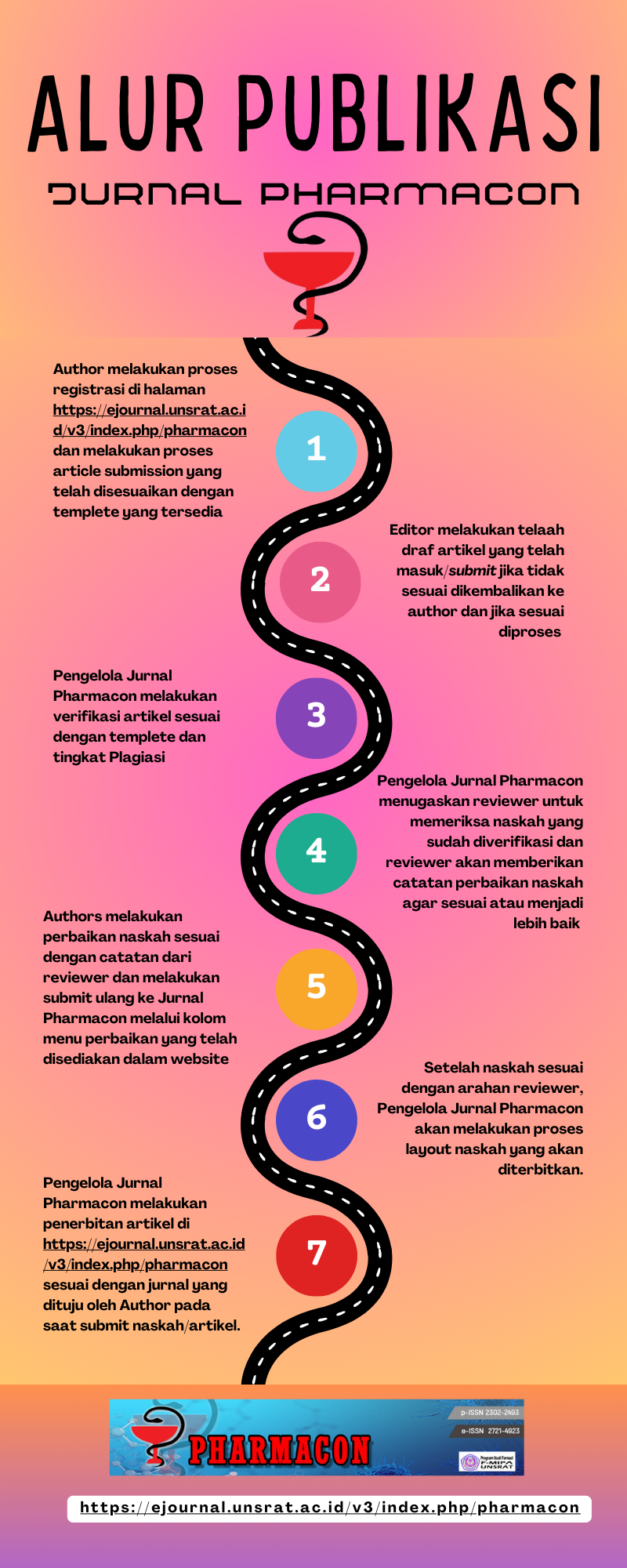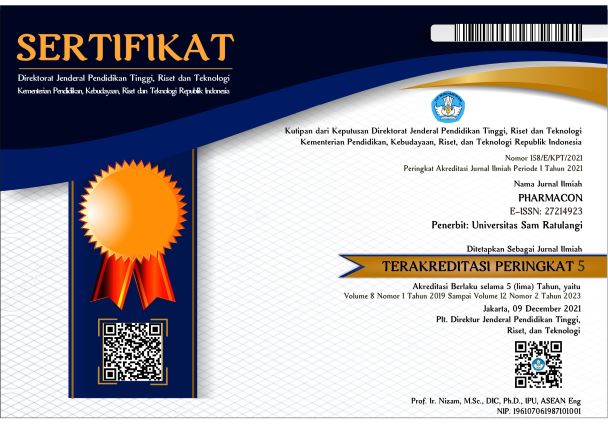UJI DAYA HAMBAT EKSTRAK DAUN SIRSAK (Annona muricata L.) TERHADAP PERTUMBUHAN Staphylococcus aureus SECARA IN VITRO
DOI:
https://doi.org/10.35799/pha.4.2015.10194Abstract
UJI DAYA HAMBAT EKSTRAK DAUN SIRSAK (Annona muricata L.) TERHADAP PERTUMBUHAN Staphylococcus aureus SECARA IN VITRO
Melisa R. Tuna1), Billy J. Kepel1), Michael A. Leman1)
1)Program Studi Pendidikan Dokter Gigi Fakultas Kedokteran, UNSRAT
ABSTRACT
Bacterial infections of the oral cavity are often caused by Streptococcus, Staphylococcus, and micro-organisms rod-shaped gram-negative and anaerobic. Some of diseases in the oral cavity that can be caused by Staphylococcus aureus is periodontal abscess. Giving an antibiotics can be done to overcome it. But used an antibiotics often cause bacterial resistance to the antibiotic substance. The development of an alternative treatment that does not cause side effects needs to be done. One of the plant that has been used as traditional medicine include soursop leaves. Soursop leaves is a kind of natural materials which contain tannins, alkaloids, saponins and flavonoids that function as an antibacterial. This research aims to determine the inhibition of soursop leaf extract on growth of Staphylococcus aureus. This research was an experimental laboratory with true experimental design and posttest only control design with Kirby-bauer modification method using filter paper. Study subject are soursop leaf third of the shoots were extracted by maceration method using ethanol 96%. The results of this study showed that the area of the inhibiting zone soursop extract was 12,3 mm. From the research can be concluded that the soursop leaf extracts have inhibition against Staphylococcus aureus accretion. Inhibition of soursop leaf extract third from the shoots, including a strong group. But, the inhibiting zone of soursop extract is smaller than the inhibiting zone of antibiotic.
Keywords: periodontal abscess, soursop leaf extract (Annonamuricata L.), Staphylococcus aureus
ABSTRAK
Infeksi bakteri pada rongga mulut yang sering terjadi disebabkan oleh Streptococcus, Staphylococcus, dan mikroorganisme gram negatif yang berbentuk batang dan anaerob. Beberapa penyakit dalam rongga mulut yang dapat disebabkan oleh Staphylococcus aureus yaitu abses periodontal. Pemberian antibiotik dapat dilakukan untuk mengatasi hal tersebut. Namun, penggunaan antibiotik sering menyebabkan resistensi bakteri terhadap zat antibiotik. Pengembangan suatu alternatif pengobatan yang tidak menyebabkan efek samping perlu dilakukan. Salah satu tanaman yang telah lama dimanfaatkan sebagai obat tradisional diantaranya adalah daun sirsak. Daun sirsak merupakan jenis bahan alam yang memiliki kandungan tannin, alkaloid, saponin, dan flavonoid yang berfungsi sebagai antibakteri. Penelitian ini bertujuan untuk mengetahui daya hambat ekstrak daun sirsak terhadap pertumbuhan Staphylococcus aureus. Penelitian ini merupakan penelitian eksperimental laboratorium, menggunakan rancangan eksperimental murni (true experimental design) dengan rancangan penelitian posttest only control design dengan metode modifikasi Kirby-bauer menggunakan kertas saring. Subjek penelitian ini ialah daun sirsak urutan ketiga dari pucuk yang diekstraksi dengan metode maserasi dengan menggunakan pelarut etanol 96%. Hasil dari penelitian didapatkan rata-rata diameter zona hambat ekstrak daun sirsak Annona muricata L. terhadap Staphylococcus aureus sebesar 12,3 mm. Daya hambat ekstrak daun sirsak urutan ketiga dari pucuk termasuk golongan kuat. Diameter zona hambat dari ekstrak daun sirsak lebih kecil dibandingkan dengan diameter zona hambat dari antibiotik.
Â
Kata kunci: Abses periodontal, Ekstrak daun sirsak (Annona muricata L.), Staphylococcus aureus
Â
Â
Â
Downloads
Published
How to Cite
Issue
Section
License
Authors who publish with this journal agree to the following terms:
- Authors retain copyright and grant the journal right of first publication with the work simultaneously licensed under a Creative Commons Attribution-NonCommercial 4.0 International License that allows others to share the work with an acknowledgement of the work's authorship and initial publication in this journal.
- Authors are permitted and encouraged to post their work online (e.g., in institutional repositories or on their website) prior to and during the submission process, as it can lead to productive exchanges, as well as earlier and greater citation of published work (See The Effect of Open Access)









